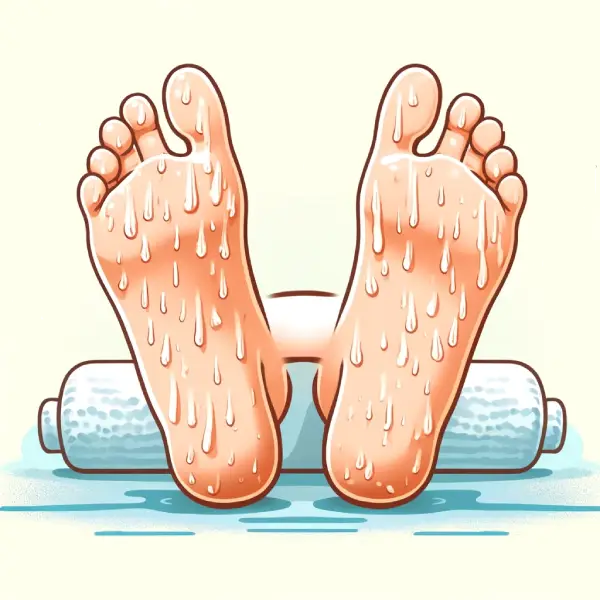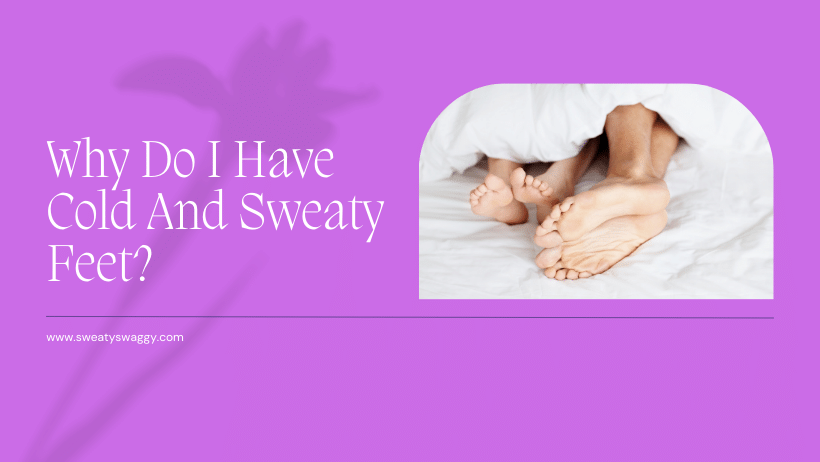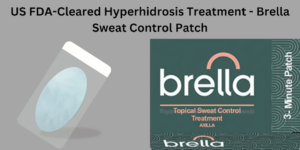Sweaty feet may occur as an emotional response of the body, due to a physical activity or wearing non-breathable shoes. However, in certain cases, where the feet are cold but sweating, the reason might be medical!
If you experience cold and sweaty feet often or on a regular basis, you may have hyperhidrosis, poor circulation, a mental health illness, or a disorder.
It’s best to visit a doctor or foot specialist if the problem with your cold sweaty feet is recurring!
But, before we jump to medical conclusions, let’s see what other factors may cause clammy feet!
Most Common Causes For Cold But Sweaty Feet
Cold and sweat are natural and normal responses of your body to different changes in our environment and temperature. They also emerge when we deal with psychological issues or pressures.
For example, anxiety is one of the leading causes of excessive sweating in many areas of your body, including your feet. Research shows that 32% of people with social anxiety suffer from uncontrollable sweating under the arms, feet, and palms.
Leading causes of anxiety include trauma, work-related stress, and enormous life changes. So, if the problem with cold sweaty feet started recently, and you are making huge life or financial decisions, the trigger might be psychological.
Another reason why you have clammy cold feet could be your footwear. Shoes that are non-breathable, uncomfortable, small, very warm, or damp, can make your feet cold and sweaty. However, the material of your socks is also very important and a contributing factor to this problem.
Medical Factors That May Cause Your Cold & Sweaty Feet
- Hyperhidrosis
- Side effects of certain medication
- Anemia
- Poor circulation
- Peripheral Arterial Disease (PAD)
- Raynaud’s disease
- Menopause
- Overactive thyroid
Hyperhidrosis
Hyperhidrosis is a condition associated with immoderate sweating affecting the whole body or certain areas of the body, your feet in this case called plantar hyperhidrosis.

The condition isn’t life-threatening, but it can be very intolerable, causing discomfort and embarrassment.
The primary reason for the excessive sweating is associated with damage to the nervous system.
The treatment of this condition depends on the stage of your diagnosis. Primary hyperhidrosis is manageable and very common. However, when the patient has secondary hyperhidrosis, almost always, struggles with another medical condition.
Common ways of dealing with this disorder are deodorants, antiperspirants, more intense hygiene routines, and special creams.
Severe measures to treat hyperhidrosis include antidepressants and surgery called sympathectomy.
Anemia
Anemia is a very common condition that occurs when your body fails to produce enough healthy red blood cells(hemoglobin) to carry oxygen to the organs and tissues.
Iron deficiency anemia is most common, although there are several different types:
- B12 deficiency anemia
- Megaloblastic anemia
- Sickle cell anemia
- Hemolytic anemia
- Thalassemia
- Idiopathic aplastic anemia and other
Commonly, anemic people experience fatigue, weakness, dizziness, sweating, and coldness in their feet.
The diagnosis is made after a physical and complete blood test.
Treatment depends on the type and stage of your anemia. Usually, doctors recommend a specific diet, vitamins, and medication. In the more severe cases, a blood transfusion is performed.
Poor circulation
Poor blood circulation happens when internal or external factors interfere with your body’s natural and complex circulatory system. Early signs include pain in the feet, legs, and arms.
Seniors, overweight, diabetic, and people who lack physical activity are usually affected by this condition.
Symptoms include swelling, cold sweaty feet, numbness, change in the color of your skin and others
It is treated surgically and with medication, depending on the course of the poor circulation.
At home, you can manage and prevent this condition with regular physical activity, healthy diet, and by wearing compression socks.
Peripheral Arterial Disease (PAD)
Peripheral Arterial Disease (PAD) is a medical condition that affects the lower extremities of the body(feet and legs). It is a life-long disease, for which, currently, there is no cure, but it can be managed.
PAD is associated with blockage or narrowing of the blood vessels that carry blood and oxygen from the heart to the legs.
The primary cause of PAD is a condition called atherosclerosis.
Some of the symptoms of PAD are :
- Pain in the legs or feet, especially during physical activity
- Muscle weakness
- Hair loss on the legs
- Absent or decreased pulse on the legs and feet
- Sweaty cold feet
- Numb toes and other symptoms!
Management of the condition include regular and supervised physical activity(exercise), walking, medication, and surgery.
Raynaud’s disease
Raynaud’s syndrome is a medical problem that happens as a result of reduced blood flow. Typically the disease affects the toes and fingers, yet in some special cases, it can also attack the ears, nose, nipples or knees.
In the case of primary Raynaud’s disease, there isn’t a known cause of the condition. The secondary form of this disease, on the other hand, is very often connected with additional medical conditions, such as lupus.
Raynaud’s can be easily managed and controlled, however it’s best to be diagnosed early, so proper treatment can be recommended.
Symptoms include changes in the skin color of your toes and fingers, swollen and painful hands/feet when wormed, sores, and others.
Menopause
Menopause is a stage in a woman’s life that affects her reproductive ability, not a disease or a condition!
A woman is considered to enter the menopausal stage of her life when she hasn’t got her period for at least 12 months. This usually happens around her late forties or early fifties.
It’s important to notice that the transition period that leads to menopause starts earlier and it’s followed by different symptoms.
In most cases, these are some of the signs for transition into menopause:
- hot flushes
- sudden coldness around the neck
- difficulty sleeping
- mood changes
- anxiety
- low or high libido
- excessive sweating in all areas of the body, including cold and sweaty feet
Menopause can be prolonged(delayed) with hormone therapy, regular exercise and a healthy diet, however it can’t be prevented!
To manage and control the menopause symptoms, your doctor may recommend hormone therapy, vaginal estrogen, antidepressants, Gabapentin and other drugs.
Overactive thyroid
Hyperthyroidism, known as an overactive thyroid is a condition where the thyroid gland produces more thyroid hormones then what your body actually needs, and speeds up the body metabolism.
This condition can affect both men and women.
In practice, women are 10 times more likely to have an overactive thyroid than men.
The main symptoms are weight loss, tachycardia, arrhythmia, hunger, anxiety, nervousness, irritability and sweating.
Treatment depends on the stage and progression of the condition. Usually, hyperthyroidism can be managed with medication and hormones, but in more serious cases surgery and radiotherapy might be recommended.
When To Visit a Doctor?
As mentioned previously in this article, sweaty cold feet are not dangerous and life-threatening. In most cases, this body condition occurs as a reaction to a certain change in our life and surroundings.
In cases where your feet are often or always cold and sweaty, it’s advisable to see your health provider!
Sweaty cold feet can indicate a medical problem or certain intolerance to some or all of your current medication. In very extreme cases, they might be a sign of a very serious illness or disorder.
If you have dizziness, weakness, chest pain, and nausea alongside your cold sweaty feet, make sure to seek immediate medical attention!
Tips and Tricks for Managing Cold and Sweaty Feet
If you have cold and sweaty feet with no medical condition, it’s best to learn how to manage and treat them!
The best way to deal with a problem is if it doesn’t exist at all!
Preventing clammy feet involves a combination of good hygiene, proper footwear, and lifestyle adjustments. Here are some effective strategies that helped a lot of people from the hyperhidrosis community:
1. Maintain Good Foot Hygiene
- Wash Feet Daily: Use mild soap and warm water to clean your feet thoroughly. Ensure they are completely dry before putting on socks or shoes.
- Dry Between Toes: Moisture can easily get trapped between toes, creating a breeding ground for bacteria and fungi.
2. Wear Breathable Socks
- Choose the Right Material: Opt for socks made of moisture-wicking materials such as merino wool, bamboo, or synthetic fibers designed to keep feet dry.
- Change Socks Regularly: Change socks at least once a day, or more often if your feet get sweaty.
3. Select Proper Footwear
- Breathable Shoes: Wear shoes made from breathable materials like leather or mesh that allow air circulation.
- Avoid Tight Shoes: Tight shoes can restrict airflow and increase sweating. Ensure your shoes fit well and allow your feet to breathe.
- Rotate Shoes: Give your shoes time to dry out completely by rotating them daily.
4. Use Antiperspirants
- Foot Antiperspirant: Apply an antiperspirant specifically designed for feet. These products can help reduce sweating.
- Foot Powders: Use foot powders that absorb moisture and reduce odor. Products containing talc, cornstarch, or baking soda can be effective.
5. Stay Hydrated
- Drink Water: Staying hydrated helps regulate your body temperature and reduce overall sweating.
6. Consider Home Remedies
- Soak Feet in Tea: Tannic acid in tea has astringent properties that can reduce sweating. Soak your feet in strong black tea for 20 minutes daily.
- Vinegar Soak: Soaking feet in a mixture of vinegar and water (1:2 ratio) can help keep feet dry and fight odor.
7. Diet and Lifestyle Adjustments
- Avoid Spicy Foods: Spicy foods can increase sweating. Adjust your diet if you notice certain foods make your feet sweat more.
- Wear Open-Toed Shoes: When appropriate, wear sandals or open-toed shoes to allow better air circulation.
8. Iontophoresis
- Really Effective: It’s effective for most of the users who tried it and was consistent with the treatments.
- Affordable: Most of the devices don’t cost a fortune and pretty much everyone can buy it. Price range is from 150$-1000$ depending on the brand and quality. Even if you can’t buy it there are DIY options but I wouldn’t risk it with those.
- Requires patience: Consistency and patience are the key when talking about iontophoresis. Sessions should be done daily and it will take at least a week for the results to show.
8. Medical Treatments
- Consult a Doctor: If home remedies and over-the-counter products don’t work, consult a doctor. They may recommend prescription antiperspirants, medications, or treatments like Botox injections or ETS, which I don’t recommend for plantar hyperhidrosis.
By incorporating these strategies into your daily routine, you can significantly reduce the occurrence of clammy feet and keep them comfortable and dry.




